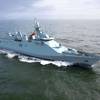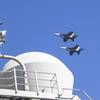By Mass Communication Specialist 2nd Class Jeremiah Sholtis and Mass Communication Specialist 2nd Class Alexander Ameen, USS Nimitz Public Affairs
Sailors from the nuclear-powered aircraft carrier USS Nimitz (CVN 68) took time during their recent port visit in Sasebo to perform passing exercises (PASSEX) with the Japan Maritime Self-Defense Force (JMSDF) and Japan Ground Self-Defense Force (JGSDF).
Six Sailors attached to Explosive Ordnance Disposal Mobile Unit (EODMU) 11 traveled to the JMSDF EOD headquarters at Sakibe Naval Base where they practiced basic underwater diving skills and Camp Ainoura where they trained with rangers attached to the Western Army Infantry Regiment.
"It was great to be able to dive and train not only in another country but with another country's military," said Ensign Karl Staehle, a platoon leader with EODMU-11. "I learned how similar we are and how joint operations like this are good for both countries."
"Japan is our most important ally in Asia," said Chief Explosive Ordnance Disposal (EWS) Christopher Cowlin, EODMU-5's Future Operations chief. "They have a tremendous amount of skill and technology from which we can learn."
Joint training exercises aren't only about education; they also help build lasting friendships and an increased willingness to cooperate.
"Being able to strengthen our bonds with the other Japanese forces in our area makes our job a lot easier when we have to do things together," said Senior Chief Explosive Ordnance Disposal (EWS/SW) Kevin Lundgren, EODMU-11 leading chief petty officer.
As part of the PASSEX, 10 Japanese service members from JMSDF and JGSDF boarded Nimitz for a guided tour of the EOD spaces and equipment. They also toured the flight deck, pilot house, hangar bay and were treated to lunch in one of the ship's wardrooms.
"This is my first time ever on an aircraft carrier," said 2nd Lt. Masataka Ishizaki, a JGSDF public affairs officer. "I'm surprised that so many people live here. It's like a small town."
The EODMU-11 Sailors said they were grateful for the hospitality they received during their time in Japan as well as the experience of working with the Japanese forces.
"This is my first time working with the JMSDF and JGSDF," said Lundgren. "They're very professional, knowledgeable and friendly people. I was surprised by how open they were; granting us access to their facilities. It was a really good experience."
Though the exercise was considered a success by the participants, they all felt there was much more that could be learned during upcoming training opportunities.
"Even though this is one of the more involved training exercises [EOD has] done with them I think there is a lot of room for growth. It definitely opened my eyes to further possibilities and training opportunities we can do with these guys in the future," said Lundgren.
In the end, the Sailors said they had a good time building new relationships while at the same time learning from their Japanese counterparts.
"Anytime we get to work with another country's service it's always a great opportunity to share information and build bridges," said Hospital Corpsman 1st Class (FMF/DV) Shaun Garner, EODMU-11 team member. "It's another day at the office and I love it. We had a good time."
The Nimitz Carrier Strike Group (CSG), commanded by Rear Adm. Terry Blake, is comprised of Commander, CSG 11, the nuclear-powered aircraft carrier Nimitz; its embarked air wing, Carrier Air Wing (CVW) 11; embarked Destroyer Squadron 23; the guided-missile cruiser USS Princeton (CG 59); the guided-missile destroyers USS John Paul Jones (DDG 53), USS Higgins (DDG 76), and USS Chafee (DDG 90); Helicopter Anti-submarine Squadron Light (HSL) 49 "Scorpions," HSL-37 "Easy Riders"; and EODMU-11.
CVW-11's squadrons include the "Tophatters" of Strike Fighter Squadron (VFA) 14, the "Black Aces" of VFA-41, the "Sunliners" of VFA-81, the "Wallbangers" of Airborne Early Warning Squadron 117, the "Red Devils" of Marine Corps Strike Fighter Squadron 232, the "Black Ravens" of Electronic Warfare Squadron 135, the "Providers" of Carrier Logistics Support Squadron 30 and the "Indians" of Helicopter Anti-Submarine Squadron 6.
Nimitz is currently operating as part of the U.S. 7th Fleet. Operating in the Western Pacific and Indian Oceans, the 7th Fleet is the largest of the forward-deployed fleets with approximately 50 ships, 120 aircraft and 20,000 Sailors and Marines assigned at any given time.
Sponsored Content
Innovative Hull Maintenance: Profitable & Green

December 2024
 Read the Magazine
Read the Magazine

 Read the Magazine
Read the Magazine
This issue sponsored by:

Propulsion Choices begin with Fuel and End with Politics
Subscribe for
Maritime Reporter E-News
Maritime Reporter E-News is the maritime industry's largest circulation and most authoritative ENews Service, delivered to your Email five times per week











